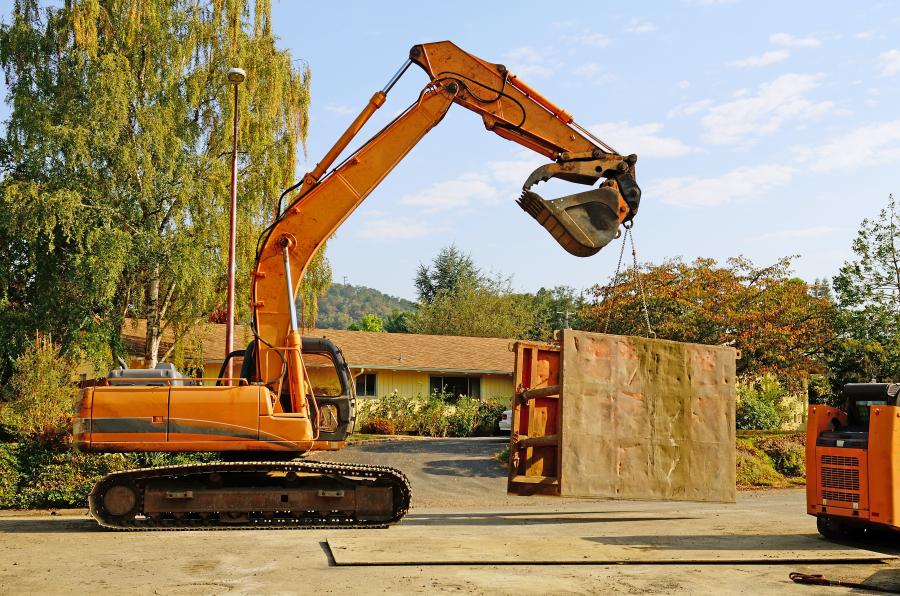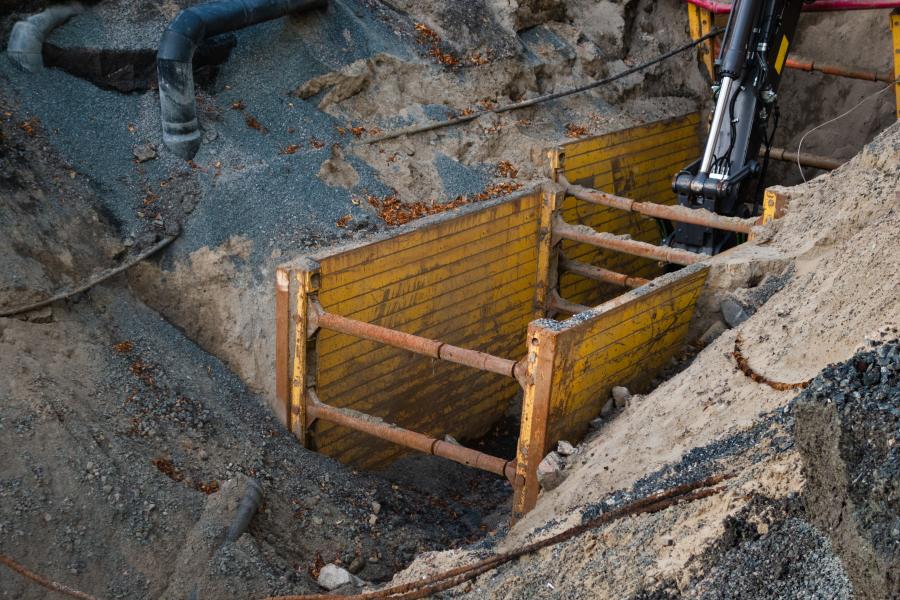Some contractors misunderstand the right way to build and install a trench box. What may be considered a minor mistake can have huge unforeseen consequences.
One of the most beneficial and tricky devices used in specialty construction, trench boxes have obvious benefits. They can hold up their end in all types of soil conditions, but they can be a bear to install and move. Understanding best practices for use of these devices can save lives and protect property.
A cage made for a construction crew to safely work in a trench, the device does not support the trench walls, but instead protects workers in the event of a cave-in.
Trench boxes are designed to be dragged along the trench using the backhoe or a crane. They allow the trench wall to be steepened to reduce the amount of excavation, backfill and right-of-way needed.
Teaching a course titled "Trench and Excavation Support Options and Excavation Slope Design," continuing education provider PDHonline.com, Fairfax, Va., explains these shields are can be used in a wide range of soil conditions.
They are heavy and cumbersome in tight quarters, and become much less efficient when underground utilities are common. Trench boxes must be lifted over the utilities or the utilities must be cut and restored later.
The devices also can cause the pipe to shift off line and grade as it is dragged forward.
For these reasons, PDH instructors advise matching box size to the configurations of the trench and trenching equipment.
"If the shield is too heavy, the backhoe or crane selected for the job may not be able to efficiently move it," they stress. "If the shield is too small, it may require many extra moves and not provide sufficient space to allow the crews to bed and set the pipe as well as such activities as dewatering."
The shield should be at least 4 ft. longer than a joint of pipe and should extend at least 18 in. above the top of any slide-prone bank, advises the continuing ed provider.
"Generally shields can be economically rented and are much less expensive than fixed shoring systems," the company added.
Cutting Through Confusion
"Used appropriately, a trench box can help protect workers from serious and sometimes fatal injuries if a cave-in occurs," said Shane Wareham, director of sales and marketing of United Rentals.
Too often, contractors misunderstand the right way to build and install a trench box, and some take shortcuts that put workers' lives at risk, said Wareham.
"A seemingly small mistake with a trench box could have huge unforeseen consequences. When in doubt, contractors should always turn to experts to help keep workers safe."
In rules set for trench box applications, OSHA requires a protective system be used when trench depths reach 5 ft. or more.
Protective systems also are required for trenches less than 5 ft. deep if the soil could cave in when the trench is dug, according to United Rentals. "A competent person must evaluate the conditions and determine which type of protective system is needed."
Though not designed to prevent a trench wall from collapsing, trench boxes protect workers from the pressure and weight of soil in the event of a cave-in.
These shielding devices are engineered to withstand great pressure from the earth that surrounds them, and are made from aluminum or steel construction in varying sidewall thicknesses
Their walls are held apart by spreaders or panels to the desired width. The soil pressures and depth ratings on a trench box are determined by their designs.
In its 29 CFR Part 1926.650-.652 Subpart P-Excavations, OSHA includes these rules on the installation and use of trench boxes:
- A contractor should install a trench box in a way that restricts its lateral movement if there's a sudden load placed on it (for instance, the earth starts to cave in or shift). The space between the excavation side and the trench box should be backfilled to ensure that it's as small as possible.
- The maximum distance between the bottom of the trench box and the bottom of the trench should be no more than 2 ft. A contractor can excavate up to 2 ft. under a trench box as long as there's no indication that the soil is collapsing behind the shield or below it and the shield is rated for the full depth.
- A trench box can be used in combination with other protective systems, such as sloping and benching. Under that circumstance, the trench box must extend 18 in. above the vertical part of the excavation walls to keep dirt, rocks and other debris from rolling into the trench. If the top of the trench box is at ground level, however, the trench box does not have to extend 18 in. above grade.
- Trench boxes must be able to handle the pressure at the depth where they'll be used and for the type of soil they'll be used in. The competent person can use the manufacturers' tabulated data to determine if a trench box is appropriate for a particular situation. If a trench is deeper than 20 ft., contractors must use a registered professional engineer (RPE) to design the trench box or select the right trench box for the depth of the excavation using manufacturer's tabulated data.
- As trenches get deeper, trench boxes can be stacked on top of one another to provide the necessary protection for workers. Each trench box must be designed to resist the pressure of the earth at the level where it's being used. Contractors don't have to use the same trench boxes for the top or the middle of the stack that they'd use for the bottom. OSHA advises using some kind of designation system to differentiate the trench boxes when they're going to be used in a stack.
- Workers can't remain in the trench box when it's being installed, taken out or moved vertically. According to OSHA Training Services Inc., the movement of the trench box can cause the soil on the sides of a trench to shift and cave in. Plus, a worker could be struck or crushed by the trench box as it is moved. "So relocate to another protected area of the trench as the trench box is being moved, or get completely out of the trench and stand in a safe place," suggested the training organization.
- People working in a trench box must have access to a ladder or other means of egress. The ladder must be secured and located within 25 lateral ft. of all workers, and it must extend beyond the top of the trench by 3 ft.
OSHA Training Services stresses workers must not climb up and down the spreader pipes.
"When using a portable ladder to enter or exit the trench, make certain it is located inside of the trench box or other protected area of the trench."
Secure the ladder against unintentional displacement, and make sure the side rails extend at least 3 ft. above the top of the ground or other landing surface "so you have something to grab when getting on and off of the ladder."
If the workers are using a structural ramp as their egress, a "competent person" qualified in structural design has to design it.
"Designating a competent person and making sure that person is adequately trained is one of the most important steps to preventing trench injuries and fatalities," noted OSHA.
In addition, OSHA requires employers "to train employees on the hazards they may be exposed to, how to protect themselves and what PPE is necessary to work safely."
Trench boxes are popular for their relative ease of installation and use compared to building a timber shoring system or other forms of protective system.
But there are a few things OSHA Training Services instructors suggest contractors and workers keep in mind when utilizing a trench box as a protective system:
- Never enter a trench box until you are certain the competent person has cleared it for entry.
- Never walk out of a trench box into an unprotected area of a trench for any reason, even if it is just for a few seconds. A cave-in can happen in a split second with little or no warning of what is about to occur.
- Be on the lookout for any missing parts or damage that may occur to trench boxes. "Broken welds, bent spreader pipes and missing retainer pins need to be reported as quickly as possible so they can be evaluated by the competent person and corrected when necessary."
- Also report other conditions that may affect the safe function of trench boxes. For example, situations where the trench box has settled in the soil and the top of the trench box drops below ground level.
- Federal OSHA standards and many trench box manufacturers do allow excavation of soil up to 2 ft. below the bottom of a trench box, but only in certain conditions. "So do not excavate soil to a level below the bottom of a trench box without first confirming with the competent person it is safe to do so; and if so, confirm how deep you can dig," stressed the training organization. CEG
Lucy Perry
Lucy Perry has 30 years of experience covering the U.S. construction industry. She has served as Editor of paving and lifting magazines, and has created content for many national and international construction trade publications. A native of Baton Rouge, Louisiana, she has a Journalism degree from Louisiana State University, and is an avid fan of all LSU sports. She resides in Kansas City, Missouri, with her husband, who has turned her into a major fan of the NFL Kansas City Chiefs. When she's not chasing after Lucy, their dachshund, Lucy likes to create mixed-media art.
Read more from Lucy Perry here.
Today's top stories
















